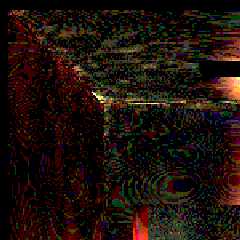|
 |
See "So please WHERE is that file ?" thread in povray.windows for details.
This little image (no need to waste server space with this even more by
posting the whole rendered images) shows the upper left corner of
"cornell.pov" differences increased to make them visible to those who have
problems seeing them.
Thorsten
____________________________________________________
Thorsten Froehlich, Duisburg, Germany
e-mail: tho### [at] trf de
Visit POV-Ray on the web: http://mac.povray.org de
Visit POV-Ray on the web: http://mac.povray.org
Post a reply to this message
Attachments:
Download 'diff.png' (10 KB)
Download 'us-ascii' (0 KB)
Preview of image 'diff.png'

|
 |
|
 |
Yeah those differences are a pain, but I've noticed that in scenes that
include some kind of texturing, you can get away with much lower radiosity
settings, because the impact from the artifacts is less apparent to the eye.
I'm speculating that the same will apply for the tiling artifacts in a
distributed render. I'm going to run some tests when I get time, but it
seems that while those artifacts cant be totally eliminated, I'm confident
that they can be greatly minimized in a realistic scene, as opposed to a
'cliche' radiosity scene like the cornell box (that has no texturing and
diffuse-only materials)
George
"Thorsten Froehlich" <tho### [at] trf de> wrote in message
news:3d5b7b8d@news.povray.org...
> See "So please WHERE is that file ?" thread in povray.windows for details.
>
> This little image (no need to waste server space with this even more by
> posting the whole rendered images) shows the upper left corner of
> "cornell.pov" differences increased to make them visible to those who have
> problems seeing them.
>
> Thorsten
>
> ____________________________________________________
> Thorsten Froehlich, Duisburg, Germany
> e-mail: tho### [at] trf de> wrote in message
news:3d5b7b8d@news.povray.org...
> See "So please WHERE is that file ?" thread in povray.windows for details.
>
> This little image (no need to waste server space with this even more by
> posting the whole rendered images) shows the upper left corner of
> "cornell.pov" differences increased to make them visible to those who have
> problems seeing them.
>
> Thorsten
>
> ____________________________________________________
> Thorsten Froehlich, Duisburg, Germany
> e-mail: tho### [at] trf de
>
> Visit POV-Ray on the web: http://mac.povray.org
> de
>
> Visit POV-Ray on the web: http://mac.povray.org
>
Post a reply to this message
|
 |
|
 |
George Pantazopoulos wrote:
>
> Yeah those differences are a pain, but I've noticed that in scenes that
> include some kind of texturing, you can get away with much lower radiosity
> settings, because the impact from the artifacts is less apparent to the eye.
> I'm speculating that the same will apply for the tiling artifacts in a
> distributed render. I'm going to run some tests when I get time, but it
> seems that while those artifacts cant be totally eliminated, I'm confident
> that they can be greatly minimized in a realistic scene, as opposed to a
> 'cliche' radiosity scene like the cornell box (that has no texturing and
> diffuse-only materials)
I think that's not a very good argument, even if radiosity artefacts are
acceptable in some situations a distributed render system that does not
take special care of radiosity will usually produce straight lines at the
tile boundaries which are much worse than more or less random artefacts.
Even if those are not visible at the first glance they will get when you
analyze the picture.
Note that rendering radiosity scenes in several parts is possible with
accepable results, especially in outdoor scenes, but this requires either
saving radiosity data before or choosing special radiosity parameters
which are often slower.
Christoph
--
POV-Ray tutorials, IsoWood include,
TransSkin and more: http://www.tu-bs.de/~y0013390/
Last updated 13 Aug. 2002 _____./\/^>_*_<^\/\.______
Post a reply to this message
|
 |




![]()